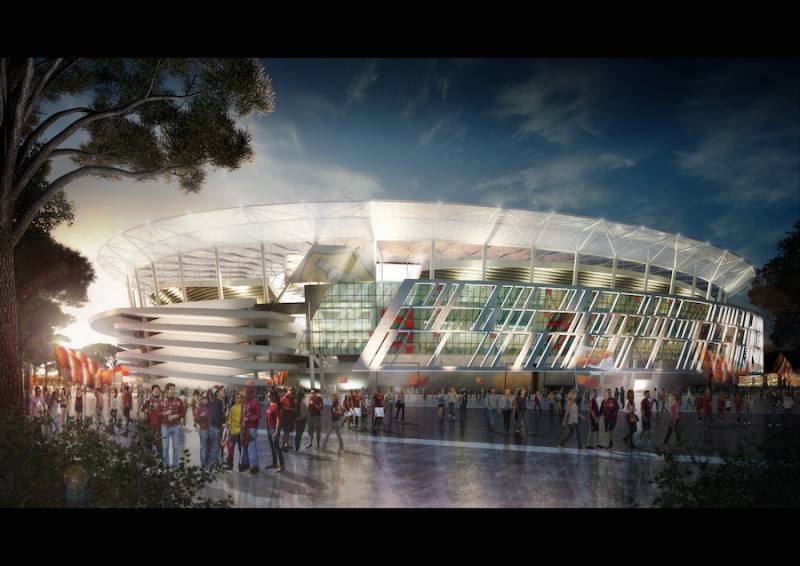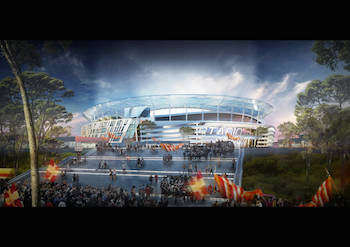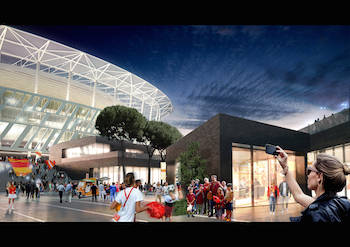Stadio della Roma: A Glorious Mix of Past, Present, and Future
If you’re interested in Italian soccer and love the eternal city, you now have yet another reason to pack your bags for Rome. A brand new architectural project, expertly fusing tradition and a futuristic vision, is ready for construction. The one and only Stadio della Roma will be built in Rome’s Tor di Valle district.
In architect Dan Meis’ words, “I was surprised to learn that there was such a large available
site at Tor di Valle. While not in the center of Rome, it is almost halfway between the airport and the city on the main highway.”
Sports,Entertainment, and Architecture Dan Meis is a renowned American architect with over 30 years of experience under his belt. He is known as one of the best architects in the world, specializing in sDpaonrtMs e&is entertainment. His works have been on display in Europe, the Middle East and, naturally, the United States. He owns studios in Los Angeles and New York that serve many locations around the world.
Raised in a small city in Colorado, Meis quickly became enthralled with the world of sports. He was also equally attracted to the physical look of stadiums, the symbolism attached to them and the way spectators get swept up in a game. “I was taken by how passionate people are about stadiums and the teams who occupy them. I love working around the world and having the opportunity to engage in the culture and passion of local fans.”
From the Colosseum to the Stadium When looking at designs for the stadium it is hard not to note its resemblance to the Colosseum, the most important Roman amphitheater and the symbol of Rome itself. As Meis puts it, “It would be impossible to design a stadium in Rome without thinking about the powerfully iconic presence of the Colosseum. We knew that a new stadium would draw comparison so we wanted to make a respectful reference to it but in a very contemporary way.
Our solution was to ‘wrap’ a modern steel and glass stadium with a floating stone scrim of Travertine that would be loosely based on the rhythms and fenestration of the Colosseum. The travertine would be quarried from the very same mountains that provided the stone for the Colosseum. In the end we hope we have created something very contemporary but that fits comfortably with the iconic monuments of Rome.”
Transformative Architecture
“I have been traveling to Tuscany on vacations with my family every year for the last twenty,” says Meis. “So I know Italy and Rome very well.” But the cultural research he conducted while working out designs for Stadio della Roma is not simply the byproduct of his passion for all things Italian;
he is also interested in Italian fans, whom he admits cannot be easily placed into a convenient socio-political box. “Football fans are far more passionate and knowledgeable about their sport than any other,” he says. “Americans do not completely understand this yet, but it is changing. I am quite sure this type of soccer will be as popular in the U.S. as the NFL someday.”
Tor di Valle may feel peripheral now, but thanks to the Stadio, it should soon become both a sporting hub and an artistic and cultural center operational seven days a week. “The idea is to transform this area into an entirely new sports, entertainment, shopping, and business district,” says Meis. “A new attraction in a city with some of the world’s most famous attractions.
The stadium is envisioned to set a new bar for what’s state-of-the-art, not just in Italy but globally.” Stadio della Roma should be ready for the 2018 season and we’re hopeful it will pay proper homage to “I Giallorossi” (The Yellow- Reds) and the city of Rome.






































i-Italy
Facebook
Google+
This work may not be reproduced, in whole or in part, without prior written permission.
Questo lavoro non può essere riprodotto, in tutto o in parte, senza permesso scritto.